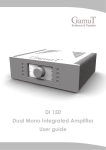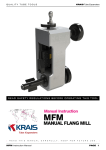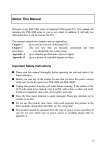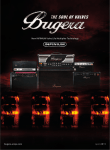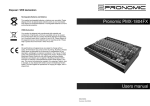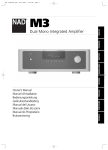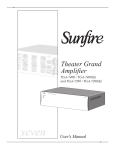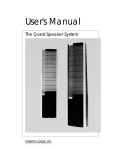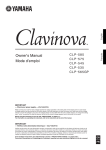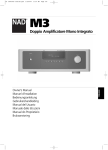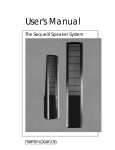Download Users Guide GamuT D200 MkIII Dual
Transcript
GamuT GamuT International A/S, Oesterled 28, Bygning A, DK-4300 Holbaek, Denmark Telephone no: int + 45 70 20 22 68 Telefax no: int + 45 59 43 97 26 www.gamutaudio.com Users Guide GamuT D200 MkIII Dual-Mono Power Amplifier GamuT International A/S, Oesterled 28, Bygning A, DK-4300 Holbaek, Denmark Telephone no: int + 45 70 20 22 68 Telefax no: int + 45 59 43 97 26 www.gamutaudio.com Users Guide GamuT D200 MkIII Dual-Mono Power Amplifier SAFETY INSTRUCTIONS: - Never let children (or grownups) push anything into holes or slots in the case - this could result in an electric shock and could cause damage of the set. - Never guess or take chances with electrical equipment of any kind - it is better to be safe than sorry. Warning: To prevent fire or shock hazard do not expose this appliance to rain or moisture Warning: No user serviceable parts inside. Refer servicing to a qualified technician. Never remove covers unless qualified to do so. This unit contains dangerous voltages. DO read the user’s guide before you attempt to use this equipment. DO ensure that all electrical connections ( including the mains plug, extension leads and interconnections between pieces of equipment ) are properly set and in accordance with the manufacturer’s instructions. Check that the mains fuse rating is set correct for your local mains voltage. DO NOT obstruct the necessary all-around ventilation: Especially DO NOT place the set close to curtains or on soft furnishing such as carpets. Overheating can cause unnecessary damage and shorten the life of the set. 2 Unpacking. Remove the 4 top blue foam corners. Open the inner box, remove the 2 top blue foam parts Lift the amplifier up and place it on its feet. Be careful not to damage the gold plated connectors on the back panel. Keep the box and the blue foam, it is specially made to protect the amplifier well, and you may need it some day, when you move or you want to upgrade the amplifier. Connecting the input cables. The main inputs are the two 3-pin XLR sockets. They are electronically balanced, and they will therefore reduce hum pickup in the input cables. So the best choice of cable is a balanced XLR cable, coming from a balanced output on your preamplifier. In case you have a preamplifier with only RCA outputs, you can use the RCA inputs. Move the switch towards the RCA. Use only one input, RCA or XLR, not both. We recommend purchasing our balanced cable wired with a male XLR in one end, and an RCA plug in the other end. This will give you partly balanced operation in the cable, with an unbalanced source. You release the XLR connector by pressing on the release button next to the XLR socket, and pulling the XLR plug out at the same time. Do not pull on the cable, only on the plug. The XLR connector: always connect Pin 1 (the ground) first and disconnect it last. This way, XLR connectors can be plugged and unplugged while the amplifier is switched on. However, some DC from the preamplifier may still cause loud clicks, so it is recommended to wait 10 seconds and then switch the power amplifier on as the last precaution. If you use a tube preamplifier, please wait several minutes the first time you use it. Also do switch off the power amplifier first, before switching off your preamplifier or any source. DO NOT CONNECT LOUDSPEAKER WIRES OR OTHER HIGH VOLTAGE CABLE TO THE INPUTS. Warming up The GamuT power amplifier will play sound a few seconds after you turn it on. However, please allow minimum 30 minutes before you start serious listening, as the sound quality will slowly improve, because all the parts need to reach their optimum operating temperature. You may also note a slight improvement in the first months of use. This is caused by the capacitors, which do improve with use. A CD player in repeat mode can speed up the process while you are not at home. Do not play too loud. After this break-in period is over, simply switch the GamuT on when you get home, and it will be ready to perform at its best after dinner. Sensitivity (Gain) Inside the cabinet, at the top edge of the circuit boards, is a dual piano switch marked -6 dB and -12 dB. Normally, gain is factory set at -6dB or 29dB total voltage gain. Your dealer can set them for you, so that you get the best match for your preamplifier. To match a passive "preamplifier" like our GamuT control unit, the gain has to be high, so set both switches to "off". Some preamplifiers also need maximum gain, others have a lot of gain in their output section and therefore should be used with the -6 dB or -12 dB switch moved away from "off". If both switches are moved away from "off", then the gain is reduced by 14 dB. We recommend that with 4 Volt sources like our GamuT CD player. Noise levels will be lower. We use switches, because they can be set precisely identical and will preserve the stereo balance. The maximum voltage gain of GamuT D200 MkIII is 35dB, and the GamuT C100, D100, M200 and M250 also have 35 dB maximum gain, so they will all work together in a bi-amped system. 3 Cleaning the cabinet The front panel is made of aluminium. It can be cleaned by using normal mild solvents and clean paper tissue or cloth. Do not use excessive amounts of solvents, and do not let any of the solvent spill into the amplifier. The Brass logopanel is covered with a protective layer. DO NOT USE ANY BRASS POLISH. You will remove the protective layer. The protection circuitry The ideas for the protection circuit come from our professional amplifiers, where it has worked well since 1982. Due to the rugged MOSFET, we can allow high peak currents , and we only need to mute the input signal in case of long-term overload. The protection detects DC errors, high level subsonic signals, long-term ultrasonic signals, high temperature, and to low impedance loads or short circuits. If needed, the protection will simply mute the input signal, and if necessary open the output relay. The relay will normally open only after muting the input signal to avoid relay switching of strong currents that could corrode the relay contacts. So in case of i.e. a short circuit the input is muted for a second. Then a 1 millisecond long pulse is sent out to test again. If the short circuit still is present, it waits a second and tries again, and so on. One second after the user has removed the faulty cable, the system will quickly remove the muting. The protection also detects too low impedance loads, and alerts the user by muting for a second. So the user can be sure to hear only clean non-distorted audio. The normal current limiting and momentary distortions of the music are avoided in the GamuT D200 power amplifier. A second of silence You may experience a second of silence while the music is playing loudly. This is the protection acting to protect your tweeters. Any amplifier will start to clip the top of the music if you exceed the maximum power level. Technically, clipping generates a lot of high frequency energy, which can burn out the tweeters in your loudspeakers. The protection constantly checks the energy above 20 kHz, which humans do not hear. The distortion is momentarily very high anyway, because you have exceeded the maximum power, so just reduce the level a bit. You can also provoke the subsonic protection by playing warped records without using a subsonic filter. Please check your tonearm/cartridge resonance frequency, which should be about 8-12 Hz to reduce the effect of warped records. Connecting your loudspeakers to the output terminals Normal power amplifiers have a coil in parallel with a resistor between the amplifier and the output connector. Its purpose is to protect the amplifier against capacitive speaker and cable loads. However, this will slightly reduce the fidelity of the sound in the treble range, when the amplifier is used with normal loudspeakers. So we have added a direct output in addition to the normal filter protected output. The red terminal closest to the heat sinks is the direct output. The other red terminal is the filter output. The white terminals are ground This also gives you the ability to connect biwiring nicely, using the filter output for the bass. and the direct output for the treble In case of biwiring an electrostatic loudspeaker, the reverse should be done. Inside the cabinet the ground terminals are kept biwired until they meet at the main star ground point. So please do not connect them together. 4 The red terminals go positive when there is a positive signal on the Pin 2 on the input XLR. In other words, GamuT amplifiers are non-inverting. Some other brands of amplifiers do not follow this standard. Take care if you want to bi-amp. Do also note that JBL speaker units are wired inverted. WARNING! Do not use this direct output for tests with square waves or sine waves and a capacitor across the output terminals, as you may damage the amplifier. Do not connect output ground to input ground. Do not connect any output grounds together. Do not connect headphones to this amplifier without using protecting resistors. Make sure, that you do not let any tiny part of the speaker cable going to a terminal touch the other terminals. Only connect this amplifier to loudspeakers, and only one loudspeaker on each channel. Do not connect the output of this amplifier to another amplifiers outputs or inputs. DO NOT CONNECT A RED TERMINAL TO ANOTHER RED TERMINAL! DO NOT BRIDGE THE AMPLIFIER! DO NOT USE BOTH CHANNELS TO DRIVE ONE LOUDSPEAKER! Loudspeaker impedance Most loudspeaker are 8 or 4 Ohm, and they are specified so by the manufacturer. Unfortunately, some loudspeakers have an impedance, which is much lower than specified. They will not damage the GamuT power amplifier, because it will simply mute. In the GamuT D200 MkIII, we use a gem of a MOSFET transistor. It handles 500 Watts, and a peak current of 300 Ampere and 100 Ampere long-term. Such high currents will destroy any HiFi loudspeaker we know of. The lower the impedance, the higher the current will be. Somewhere, we have to draw a line between what is a loudspeaker load, and what is a short circuit. We have set this line at 1.5 Ohm, which will draw about 47 Ampere peak. The impedance of a few electrostatic loudspeakers does go down below 1.5 Ohm at high frequencies. The protection circuit will not allow this long-term on test signals. However, it works well with Quad ELS63 and most Martin Logan electrostatic loudspeakers. Please also note that a Quad ELS-63 electrostatic loudspeaker cannot handle more than 55V peak, and the GamuT can give more than 70V peak. So be careful. A lifetime of enjoyment So far, our oldest amplifiers from 1982 still work in professional recording studios, often doing their job 16 or 24 hours a day. So we expect our GamuT amplifiers to do likewise. A more likely cause for change would be your wish to upgrade in some years time. Here our modular approach serves to keep the upgrade cost low, and you avoid selling with a loss on the second hand market. The cabinet should last a lifetime, and the GamuT Logo is engraved down into the surface; wearing the text out will be quite difficult. Apart from being good economy, this long term approach is also better for the environment. Most parts of the cabinet are made of aluminium, which is easy to recycle. All parts are screwed together to enable easy disassembly. Your grandchildren will be pleased with your choice. 5 Normal use When you switch on, the blue light in the front will light up to confirm you have mains power on. One second later two small clicks can be heard from inside the amplifier, they confirm, that the amplifier has connected the loudspeakers using the output relay. One second later still, there will be two clicks in the loudspeakers. These clicks are your confirmation that the protection system have found everything to be OK. The input signal can now pass through to the loudspeakers. Each channel has its own protection circuit, so the click from one channel may arrive delayed compared to the other channel. DO NOT Do not switch the amplifier on, then off, then on again quickly. The blue light must disappear completely, before you switch on again Only switch on and off using the power switch Unplugging the mains cables, while they carry current will corrode and damage the surface of the metal of the mains plugs and sockets. This can cause reduced sound quality and electrical fires. The mains switches have special metals in the contact points selected for handling high in-rush currents, as well as to break large currents. Plugs and sockets are not made of such metals. What you can check if you do not get sound Is there light on the front panel? If not, have you plugged in the mains cable correctly? Is the fuse broken? Check both in the plug and on the back panel of the amplifier. Do you have mains power on? Check the mains socket by plugging in another working unit. Only change a blown fuse once, and use the spare slow blow fuse located in the mains socket on the back panel of GamuT M 200. Use only the special spare fuse in the fuse holder. For 230-240 Volt Mains use sand filled 5 Ampere slow blow fuse type marked T5AH For 115-120 Volt Mains use sand filled 10 Ampere slow blow fuse type marked T10AH If the fuse blows again you must consult your dealer, the amplifier is most likely defective, and it can not repair it self, so changing fuses many times will not help. Changing the fuse more than once can increase the repair price, and you can cause a fire or a deadly electrical shock. These sand-filled types can break up to 1000 Ampere current, a normal slow blow fuse can only break 35 Ampere, so it may not stop the current! If you have light on the front panel and only one channel is playing sound, then take its input cable, and put it into the quiet channel. If it still is quiet, then unplug the loudspeaker cable from the OK channel, and use it on the quiet channel. If it still refuses to play sound, it is likely to be defective. Call your dealer. 6 If both channels are silent, but the blue power lights are on, you can check them in the following way: Switch off power and wait 10 seconds and then switch it on and listen carefully. There should be two quiet mechanical clicks coming from the inside of the amplifier. If not, disconnect the input cables and try again. Now listen closely to the loudspeaker. A small click should come from the loudspeaker, just after the click from inside the amplifier. If not, check the loudspeaker cables. If you hear clicks in the loudspeakers, and still do not get sound, the amplifier is probably OK.. Try exchanging the input cables with another cable. and check that you are sending signal by sending it into a tape recorder. If you only get the mechanical click (it comes from the relay closing inside) and you have checked the loudspeaker cables and the loudspeaker, then you should call your dealer. If you hear small clicks every second from the loudspeaker, then you have a bad input signal, or a short circuit on the output, which causes the protection circuit to take action. Check that the input cable screen is OK and that all plugs are tightly and correctlt connected. Check the loudspeaker cables. In case you cannot solve the fault by doing the above, call your dealer. A few useful specifications Shipping weight is 31 kg. Dimensions are 164 mm high, 431 mm wide, and 470 mm deep. Idle power consumption is 100 Watts. The slow blow mains fuse limits power consumption at 1,150 Watts long-term. Output power in 8 Ohms resistive load is 200 Watts or 23dbW. Speaker loads below 1.5 Ohms are not allowed by the protection circuit Noise is at least 100 dB below 200 Watts in 8 Ohms. This depends on the gain selected, and it is below the noise from a CD. Strong external electromagnetic fields can increase the noise level. Use only shielded signal cables. The balanced XLR input has a 40 kOhm input impedance. The 3-pin XLR socket has Pin 2 as plus, Pin 3 as minus, and Pin 1 as ground. The RCA unbalanced input has a 20 kOhm input impedance. Sensitivity can be selected internally by your dealer to be 0.775V, 1.55V, 3.1V or 3.9V for full power. The output for a loudspeaker is single or biwiring, using 4 mm banana plugs, spade lugs or stripped wire. The Service Most of the parts are on the circuit-board, which can be changed at a low cost, should your amplifier ever need service. You can contact your dealer, whom may solve your problems locally, or you can contact us in Denmark. Please note your dealer’s telephone number here: 7 Interesting trivial facts It may interest you to know that the output voltage is 55 times the input voltage at maximum gain. However the input signal current in the 20kOhm RCA input is only 38.8uA at full power, and the output current is 10.7 Ampere at full power in 4 Ohm, as current gain is 275,000. Power is voltage multiplied by current, so output power is 15,100,000 times larger than the power of the input signal. Yes, a power amplifier is a suitable name for what it does. And note that this input signal power is still more than 10,000,000,000 times more powerful than the residual noise power at the input. So in 4 Ohm, full output power is more than 151,000,000,000,000,000 times larger than the input noise power. So do take care to place your signal cables apart from your loudspeaker cables. They should not lie close together, and if they need to cross, they should cross at a 90 degree angle. Do not use un-screened interconnect cables. The current in the mains power cable is a very distorted version of the signal, and it contains very high frequencies. A special power cable can reduce radiation of interference, and it can improve your sound quality. 8 Recommended CDs This is a list some of the recordings that have been used to evaluate the sound quality of this amplifier. The LP version can be superior, but it is difficult to obtain. Most recording engineers today try to make the music sound fine on the cheapest stereo systems, simply because they are in majority and thus brings more sales of CDs. The following recordings will test the limits of a eigh-end system, from the subtle to the outrageous. They combine this with being very enjoyable for the artistry of the musicians and composers. Verve 521485-2 Verve Grammy Winners Stan Getz/Joao Gilberto track 9, "The Girl from Ipanema" This recording gave Phil Ramone a Grammy for best sound in 1964. Many years later, it still allows you to dim the lights, make a nice cool drink and imagine you are in Brazil with the girl standing very close to you, singing her song quietly in your right ear. This is what a high-end system is all about, to recreate the past so vividly, that the emotions of the past performances can be experienced again and again. It is interesting to hear how different the same track sounds on Verve 521 414-2, the digitally re-mastered version of the album. And then try hearing the LP from 1963, Verve V6-8545. Reference Recordings RR-70CD Stravinsky, Eiji Oue conducting the Minnesota Orchestra The full dynamics of Stravinsky requires a HDCD recording. The quiet opening of the first track lets you hear the sound of the concert hall, and the big drum will surprise your friends or your speakers. Almost visual three-dimensional sound. "The rite of spring", well, Stravinsky wrote this based on the sacrifice of young girls to please the old gods. It is not pleasant for the humans involved, and it should not sound pleasant. If you want to relax, choose the next CD instead. dmp CD-457, Warren Bernhardt, “Hands On” The first track opens up with a very grand piano played in classical music style, which later transforms into very relaxed jazz. Natural detail indeed; you hear the piano sound as felt hammers hitting metal strings, and also the unique series of resonances from strings, metal frame and wood. A fine Steinway or a Bösendorfer grand piano costs about EURO 100,000. Is it reasonable to expect a stereo system costing much less to reproduce it perfectly? Deutsche Grammophone 427 772-2, “Horowitz at home” The poor studio technician had to come to the master’s home this time and make this recording. Fascinating, very difficult recording to reproduce, but with a core of golden inner details.. Compare the two types of piano sound, this and dmp. A good stereo system must highlight the differences between different recordings and play both of them well. Vertigo 800 051-2, Dire Straits, “Dire Straits”. Track 4, "six-blade knife", is actually better than several of the later recordings. This is due to the mixing console; the expensive console used for the later recordings is known for its harsh sound, but it was used in many large studios due to its excellent automated mixing computer system Yes, there is tape hiss, but the detailed bass guitar and soft drums are wonderful to hear. Warner Bros. 7599-27313-2, Fleetwood Mac, “Rumours” Many excellent tracks, "Oh Daddy" being one of the best. It was a huge best-seller, nice to see that quality is rewarded by the public. It has some three-dimensional qualities, which normally is a non-existent feature in rock or pop recordings. Compare depth to: 9 EMI CDS 7 54368 2 Georges Bizet “Carmen” with Maria Callas The conclusion of Act II opens the second disc. You can hear the male singer walking across at the rear of the hall while singing, and later walking towards stage center front. The recording is a reference for three-dimensional sound. On a fine system, you can measure the size of the hall with your ears, and on the best systems you can hear that he walks deeper into the stage while walking across from right to left. You can clearly hear the acoustics change while he is walking. The recording is from 1964, it has some distortion at high levels, and Mrs Callas was always a bit shrill sounding, but who cares when the drama unfolds like this. It is like "seeing" with your ears. The new remastering EMI 7543 5 566281 2 1 fortunately retains most of the magic. Telarc CD-80098, Erich Kunzel and Cincinnati Pops Orchestra, „Ein Straussfest“ Telarc show here that CD strings can be sweet sounding, and the first track, "Explosions Polka", will jolt everybody when it starts. On a fine system, the explosion is extremely fast and splits in an air-blowing attack, a roar and a decay of the hall, just like a real New Year’s celebrational explosion sounds. Warner Bros. 7599-26656-2 “Fourplay” Bob James, Lee Ritenour, Nathan East and Harvey Mason cooking together is an experience to be savoured. A dry studio recording, not much depth to speak of, but exceptionally clean. The first track builds slowly into a crescendo, which will test the system’s ability to resolve a complex sound at high levels over a longer time. A power supply and heat sink test. When the level goes down at the end, the sound should be the same as in the beginning. This CD has been used at many shows, and it does not fail, many visitors ask for the label and number, so that they can go out and buy it. Finally, we wish you many years of enjoyment. With our best wishes, GamuT International A/S GD200MK3OW/2004 10










